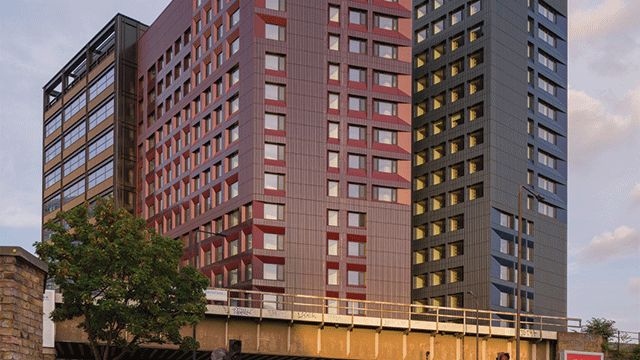With public capital unavailable, Reits are looking to internal growth, consolidation and institutional money to try and regain favour with investors. Meanwhile, a buoyant US economy and the glamour of the internet company occupiers are promising continued growth for the property sector
While the US real estate market has bounced back from a turbulent 1998, the long-lasting consequences for the public real estate market are still hanging over the sector and the market. The withdrawal of capital from the public markets in the wake of international financial shocks destabilised the Real Estate Investment Trusts (Reit) market in a flash. And money is still flowing freely out of the public side of the market – $20bn over the last two years and in the third quarter of 1999 an average weekly outflow of $10.7m.
It was quite a shock for a sector that was revelling in popularity with mutual funds, pension funds and retail investors. There are also wider consequences for US real estate; with the sector now having this publicly-held slice, the whole market is more sensitive to share price changes and shocks.
With the sheen gone from the public markets, Reits have seen their discounts to net asset values increasing leading to publicly-traded real estate becoming cheaper than private. For example, at 1 November, Equity Office Properties’ discount to NAV was 20% and CarrAmerica Realty, which owns serviced office provider HQ Global Workplaces, had a discount to NAV of 33%.
To survive, Reits are exploring different options: consolidation, going private and improving their asset market. While this happens, the direct market is reaping some of the diverted funds.
Part of the problem for Reits has been their relatively short history. As Jacques Gordon, director of investment research at LaSalle Investment Management, explains: “The real estate market has got so many different aspects. The public market is the piece we are still trying to get used to. It is still really a new era – only five years old – and investors are confused, surprised and disappointed that it didn’t grow 20% per year forever.”
There is also a wider macro-economic issue. “Reits are, along with other stocks, out of favour. They are having to compete with internet and e-commerce stocks that are income and value orientated rather than purely asset based,” he says. He adds that Reits’ problems could be partly resolved if there was a correction in the seemingly high value put to internet companies. Investors then may want to divert some of their funds back into stocks which have income backed by assets.
But the problems being experienced by the public sector have not broken the spirit of the private buyers. Private money has always dominated the market – Reits had a dramatic rise but still only represent around 10% of the market. According to Jones Lang LaSalle, the flow of capital from private buyers is up 10% to 15% over last year. While in the first quarter of 1999, Reits and other public real estate-owning companies bought $3.6bn of assets, down from $22.4bn for the same period in the previous year, according to Real Estate Alert, produced by Hoboken.
There is also more confidence from the institutions; they are more inclined to use leverage – if only conservatively – which was not the case five years ago. “Pension funds two years ago were undecided whether they should be in Reits or direct property,” says Gordon. Last year’s turmoil has reminded them of the benefits of investing directly. Institutions such as Calpers and the Ohio Teachers Fund are committed to private buying. There is also some international activity. German open-ended funds have been leading the charge. For example, Despa has bought buildings in Washington, DC and San Francisco.
The slice from institutions for opportunity funds is still also being maintained. With the maturing US market, more funds are expected to be allocated to Europe or Asia.
One solution for the Reits has been undertaking mergers to try and increase shareholder value, or to take the companies private. Both Sunstone Hotel Investors and Berkshire Realty, backed by Goldman Sachs’ Whitehall Street Real Estate Limited Partnership XI, have recently been taken private by their management.
Another Reit, Walden Residential, was bought by Olympus Real Estate in a $1.7bn deal, breaking down to a purchase price representing a 24% premium over the company’s share price.
Analysts are surprised there hasn’t been more consolidation, but recognise the problems. “It is not easy to do. A board of directors would question a management buyout. There is also the capital needed to do the deal. Their average market cap is $1bn; not many Reit managers can raise this,” says Gordon.
Instead, Reits are taking what is seen as a more considered approach. Rather than raising money and stocking their portfolios with assets, they are spending more time on their existing portfolio.
“It is a healthy thing. Most Reits were developers that went public. They now need to be good portfolio managers,” says Gordon.
For Gordon, this makes the sector worth another look. “In my view Reits are an attractive price, especially ones that have made the transition from the developer mentality and have turned portfolio manager and understand the challenges of being a public company.”
Reits are also recycling capital by selling assets they have held for a number of years realising the increases in value.
Some are also getting over the lack of public capital through joint ventures with institutional partners, says JP Morgan. The institutional partner provides most of the equity – usually 50% to 80% – to buy a pool of assets while the Reit as the junior partner also gains some management and leasing fees. Europe is seen as a lucrative source of equity for this type of funding.
Security Capital takes a strategic hard line
Security Capital is one high-profile public real estate company that has had to take a hard line to suit the changing attitude to the sector. The company last month released a healthy set of results – earnings before depreciation, amortisation and deferred taxes was $60.1m compared to $42.1m for the same period last year – but it has had to introduce restructuring and stock purchase programmes to keep up investor confidence.
A $100m stock buyback programme was introduced in August to bolster its flagging share price. It currently stands at around $13 compared to $25 last summer. It has so far spent $53m, gaining 3.1% of the outstanding shares. “By buying back our own stock, we are investing in an opportunity that we fully understand, and one where we expect to realise a high total rate of return,” says chairman William Sanders. Accompanying the third quarter results was a severe restructuring programme to cut out the dead wood. Its investments must now be able to “create significant brand value and ultimately achieve one of the top two market positions in their respective niches. To achieve these objectives, Security Capital will sell or reposition its investment companies that do not meet these criteria,” said Sanders.
The restructuring is unlikely to affect the company’s European investments. The company owns one third of Security Capital European Realty, the owner of European companies including developers Bernheim Comofi and Akeler, and self-storage operator Access. Green Street Advisors analyst Craig Leupold said: “I don’t see it having much of an impact [in Europe]. This is an area where the company is still focusing its growth, and it has a lot of capital invested.” He said it was more likely to hit the smaller start-up businesses that need more investment as the company was more inclined to spend its capital buying shares.
US economy in rude health as real estate market rings the changes
The changes to the public real estate market are coming during a healthy period for the US economy and the real estate market. The US economy performed well in the first half of the year; the unemployment rate slipped back to 4.3% in June, after hitting a 29-year low of 4.2%, GDP growth for 1999 is expected to be 3.5% while inflation is low at 2.1%.
Cushman & Wakefield report an office market in equilibrium at the end of the second quarter of 1999. Average vacancy rates were 10.1% in the central business districts and 12.2% in the suburbs. Rents rose a healthy 3%, a slowdown from the 1998’s high growth of 9%.
While C&W predict that CBDs will absorb more space than is delivered in 1999 and early 2000, there is a fear that a continued high pace of construction could be a drag on all sectors right through 2001. This could be particularly worrying if there are more corrections in the public market, sapping economic confidence. “A small correction (less than 10%) might remind investors of the need to invest in stable income-generating assts, like real estate, without affecting the positive momentum in the leasing markets,” says JLL’s latest US market outlook. “A large correction (more than 20%) could have an immediate, negative effect on leasing and investing volumes – leading ultimately to a drop in commercial real estate values.” The strongest CBD markets will continue to be New York, Boston, Washington DC and San Francisco.
It is also hoped that construction will be tempered by restrictions on financing. Conduit lenders have bounced back from when CMBS spreads tripled, but they are not as aggressive lenders as in early 1998.
On the ground, many markets are experiencing the so-called “dot com” phenomenon as requirements for internet and e-commerce companies grow on a daily basis.
“The most visible market in the New York has been new media,” says Joel Herskowitz, executive managing director of Newmark & Company, part of the Oncor network. “There are companies that are just starting who want 1,500 sq ft to 2,000 sq ft. For the second stage all of a sudden they want 8-10,000 sq ft before jumping to 30-40,000 sq ft and on to 80,000 sq ft, 100,000 sq ft and 150,000 sq ft.” While they may start in secondary or tertiary space, they soon move on to prime locations. The phenomenon is also being repeated on the West Coast.
With much of the growth on the back of climbing share prices, there is a fear that any correction could sharply pull back requirements. “These companies have a tremendous paper value but no proven asset base, so landlords are asking for significant dollars in security deposits,” adds Scott Panzer, senior managing director of Newmark.










